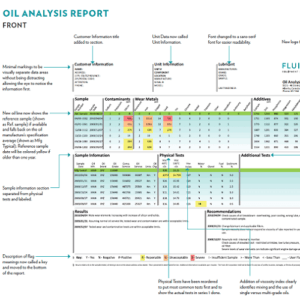Oil analysis is often misunderstood in equipment maintenance. While it’s widely recognized as a powerful tool for predictive maintenance, myths and misconceptions can hinder its effectiveness. Let’s take a look seven common myths about oil analysis and equipment maintenance and explore why they’re inaccurate, giving you a clearer understanding of how to make oil analysis work for your equipment’s reliability.
Myth #1: “Oil Analysis is Only Useful for Detecting Oil Problems”
Many believe that oil analysis is solely about the oil itself—whether it’s too contaminated, too thick, or breaking down. In reality, oil analysis provides critical insights into equipment health. By examining oil samples, you can detect issues such as abnormal wear, contamination, and environmental factors affecting the system. For example, the presence of metal particles in the oil can reveal internal wear or corrosion. These insights help technicians address small issues before they evolve into major, costly repairs.
The Truth: Oil analysis is about the equipment just as much as it’s about the oil. By focusing on the oil’s condition, you’re missing valuable data that can indicate wear and tear on machinery components.
Myth #2: “Oil Changes Should Always Follow a Set Schedule”
Routine oil changes are a staple in preventive maintenance programs, but many people still follow strict, fixed schedules—often set by manufacturer guidelines—rather than basing them on real-time data. This approach can lead to unnecessary oil changes and waste, or worse, delayed oil changes that miss critical signs of degradation.
The Truth: By using oil analysis, you can identify the actual condition of the oil and determine the optimal time for a change. Extending oil life through analysis saves money, reduces environmental waste, and ensures oil changes are performed when necessary.
Myth #3: “Once Oil Analysis is Done, the Results are Set in Stone”
Some think oil analysis provides one-time, static data about oil and equipment condition. However, oil analysis is most effective when conducted regularly. Conditions within machinery can change quickly, especially in harsh environments, and what was true a month ago might not be true today.
The Truth: Oil analysis is a trending and continuous process. Routine sampling helps you track equipment health over time, identify patterns, and make proactive maintenance decisions. Only through regular testing can you build a true picture of your equipment’s condition.
Myth #4: “Oil Testing is Only Necessary for Large, Expensive Equipment”
It’s a common misconception that oil analysis is only worthwhile for high-value or mission-critical equipment. While it’s true that oil analysis can yield high returns for large assets, smaller and less expensive machines also benefit. Downtime, maintenance costs, and operational efficiency all suffer if a low-cost piece of equipment fails unexpectedly.
The Truth: Oil analysis helps prevent breakdowns across all types of machinery, big or small. It’s especially valuable in plants where downtime impacts production flow or worker safety. Comprehensive oil analysis programs provide insight into each asset’s condition, enabling informed, system-wide maintenance strategies.
Myth #5: “Oil Analysis Isn’t Necessary if Maintenance is Already Scheduled”
Many believe that if they’re performing regular maintenance on a schedule, they don’t need oil analysis. However, scheduled maintenance can sometimes overlook problems that only appear under specific conditions or after prolonged periods of use. Even a well-maintained machine can show signs of wear or contamination that routine servicing doesn’t catch.
The Truth: Oil analysis is an added layer of insight that helps you catch hidden or emerging issues early. By detecting and addressing these issues, you can prevent breakdowns and optimize your scheduled maintenance intervals, balancing preventive and predictive maintenance.
Myth #6: “Lab-Based Oil Analysis is Too Expensive and Time-Consuming”
The belief that oil analysis is overly expensive or time-intensive is common, especially among smaller companies. But modern technology has made oil testing more accessible and affordable. Portable testing devices and quick turnaround from labs can make regular oil testing part of a practical maintenance program.
The Truth: While lab-based analysis costs money, it’s a worthwhile investment in avoiding downtime and expensive repairs. In fact, oil analysis often pays for itself by preventing unnecessary downtime and extending equipment life, leading to long-term savings.
Myth #7: “All Oil Analysis Reports Look the Same”
People sometimes assume that oil analysis reports provide generic results that don’t require expertise to interpret. However, oil analysis reports vary based on factors like equipment type, environmental conditions, and oil type. Different contaminants and conditions affect equipment in unique ways, so knowing how to interpret the data is essential.
The Truth: Each report requires a tailored interpretation to understand specific wear and contamination sources. Working with a qualified analyst, such as one of our reliability experts, or using trend data allows you to get accurate insights into equipment health and make data-driven decisions.
Myth #8: “Oil Analysis Is Only for Identifying Existing Problems”
Some believe oil analysis is reactive, meaning you can only use it to address issues that have already arisen. In reality, oil analysis is a proactive tool that allows you to prevent issues before they occur. Identifying trends, such as gradual wear or contamination buildup, can give you a warning before a failure happens.
The Truth: Oil analysis is a powerful predictive maintenance tool. With regular sampling, you can create a trend line that signals upcoming problems, allowing you to plan maintenance at the most convenient times.
Final Thoughts
Oil analysis isn’t just for big machines, nor is it a one-and-done process. It’s a continuous, proactive method for managing your equipment’s health, no matter the size or industry. Understanding its full potential helps you create a cost-effective, efficient maintenance strategy that protects your investment, minimizes downtime, and maximizes the lifespan of your equipment.
By debunking these myths, you can make informed decisions about implementing or improving your oil analysis program—allowing you to focus on what matters: keeping your operations running smoothly. We can help! Contact the Fluid Life team today to get started.

